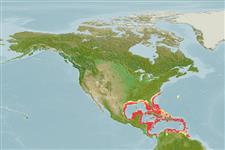Preferred temperature (Ref.
115969): 22.7 - 28, mean 26.4 (based on 328 cells).
Phylogenetic diversity index (Ref.
82804): PD
50 = 0.5000 [Uniqueness, from 0.5 = low to 2.0 = high].
Bayesian length-weight: a=0.01148 (0.00674 - 0.01956), b=3.06 (2.92 - 3.20), in cm Total Length, based on LWR estimates for this species & Genus-body shape (Ref.
93245).
Trophic level (Ref.
69278): 4.3 ±0.6 se; based on diet studies.
लौटाव (Ref.
120179): माध्यम, न्यूनतम जनसंख्या दुगनी होने का समय 1.4 - 4.4 वर्ष। (K=0.34-0.35; tm=3.5-5.5; tmax=9; Fec=260,000).
Fishing Vulnerability (Ref.
59153): Low to moderate vulnerability (33 of 100).
